What is a gas cylinder reducer: device and operation of the device with a pressure regulator
Not all settlements and summer cottages are connected with us to centralized gas supply. Unfortunately, there are also towns and villages in which balloon gas is actively used. For its safe use, a gas reducer is required - a device that reduces the fuel pressure to the values required by stoves and boilers.
We will tell you all about the guidelines for choosing a reduction device. The information presented by us will help to buy the most suitable reducer for installation on a gas cylinder. We have described in detail the types of devices and the criteria according to which a particular model should be preferred.
Those who wish to independently install and connect the reduction apparatus will help a detailed step-by-step instruction. Here you will find the rules, compliance with which will protect you and extend the service life of gas installations. The article is illustrated with photographs, supplemented by video tutorials.
The content of the article:
General balloon gear selection rules
The stable operation of the gas system depends on the quality and compatibility of all its components. When choosing a gearbox, it is necessary to take into account the correspondence of its parameters to the needs of the devices connected through it.
Scope of devices
For the gearbox, the following indicators are considered as the main characteristics:
- the type of gas that passes through the device;
- way to connect to the system;
- output pressure range;
- maximum performance;
- Operating temperature range.
Cylinders with reducers can be installed inside or outside the house.
The room in which the equipment is installed is subject to increased requirements for air exchange with the ability to quickly ventilate in the event of an emergency. The street version saves space inside the building and is safer when leaking combustible gas.
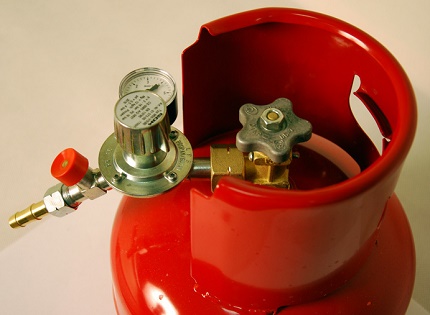
By the type of gas passed through, gearboxes are divided into the following types, each of which is painted in a certain color for additional identification:
- acetylene - white;
- hydrogen - dark green;
- oxygen - blue;
- propane-butane - red;
- methane is red.
The color coding of gearboxes manufactured outside of Russia may vary.
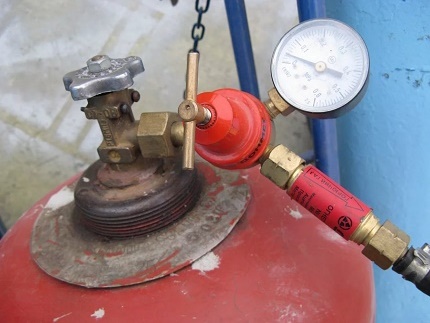
The characteristics of the gearbox purchased must comply with the parameters and type of gas bottle and the device with which it will be installed. Correct calibration of the output gas flow rate is also important.
If the pressure value exceeds the permissible range, the automation of a modern gas device will turn it off. If it is not equipped with such protection, an emergency may occur.
Gearboxes, as potentially hazardous equipment, are subject to mandatory certification. If you have any doubts about the factory origin of the purchased device, you must require the certificate of conformity.
System Connection Standards
To connect the gearbox to a gas cylinder or to a liner, 3 standards of threaded connections are usually used:
- W 21.8 x 1/14 - cylindrical thread of standard DIN 477 / T1, in Russia they often use the abbreviation SP 21.8 for it;
- G - cylindrical pipe thread, where the number after the letter indicates the nominal diameter in inches;
- M - metric thread, where the first digit after the letter indicates the nominal diameter, and the second is the thread pitch in millimeters.
Characters “LH” indicate that they use left-handed threads.
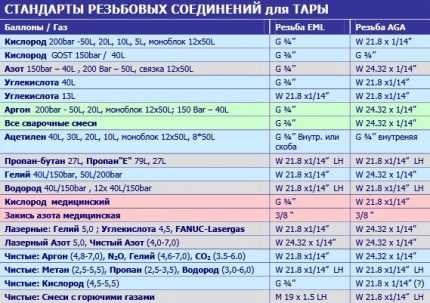
Some simple devices have only one connection option. So the popular Type 724B gearbox from the Italian manufacturer “Gavana Group S.p.A” is equipped with an input left thread W 21.8 x 1/14 for a standard metal cylinder. The output is a right half-inch internal thread for connecting a bellows eyeliner without any adapters.
The more complex Type 733 device with pressure control function from the same manufacturer already has 6 input threads: for metal and composite cylinders, for multi-valve gas tank and 3 more connections. This model also has 3 output threads.
If the input or output threads at the gearbox do not match cylinder valve or eyeliner, then use special adapters. However, it is necessary to minimize the number of such compounds, since they increase the risk of leakage. With standard gas equipment it is easy to find a gearbox with a suitable connection format.
Installation and start-up procedure
Installation is done first gas hoses without connecting it to the bottle. Then, the nut of the gearbox is installed on the cylinder valve and after that the hoses are already connected to it.
During this operation, the taps of the gas consuming device, gas column, floor gas boiler, stove, must be in the "closed" position. Before attaching the gearbox to loosen the spring, it is necessary to unscrew the adjusting screw until it stops.
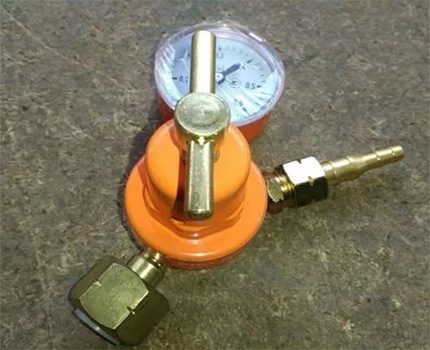
If you use an ordinary flexible hose, then for ease of performing the procedure, the reducer nozzle can be moistened with water.Such connections must be secured with a screw clamp. The bellows hoses are connected using a threaded adapter, which is screwed in place of the fitting.
After installation of the system, it is necessary to check for gas leakage with idle devices. To do this, tighten the gas flow valve (if any) and unscrew the adjusting screw in order to loosen the spring as much as possible.
If, after establishing the differential pressure, the pressure gauge needle shows a gradual increase in pressure, then the gearbox cannot be used.
After collecting the entire system, it is necessary to ensure the flow of gas from the cylinder to the gearbox and turn the control screw to set the required outlet pressure. Then you need to smear soap and water on the joints from the bottle to the consuming device to check for gas leaks.
If the gas stove serves as the consuming device, it is necessary to sequentially light the burners. If the flame is not blue on each burner, then the pressure on the gearbox must be reduced.
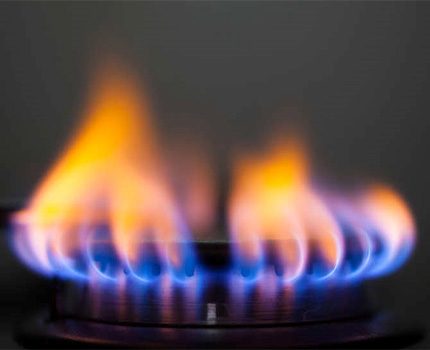
When checking the operation of burners at minimum heat, there may be a problem with their attenuation. To solve it, you need to either slightly increase the output pressure using the regulator on the gas cylinder gearbox, or change the position of the flow screw on the stove itself.
If the above problems are not typical for all burners, then on the problematic knots of the stove it is necessary to clean or change the nozzles. If there is a gas leak at the start of the system, you must close the fully shut-off valve. Then you need to ventilate the room and proceed with troubleshooting.
Necessary pressure and volume
The transmission capacity of the gearbox must ensure the operation of all devices connected to the system at the maximum gas consumption mode. Some problem of determining the necessary parameters is the use of different units of measurement.
There are two pressure units for gas appliances: Pascals (Pa) and bars (br). For the pressure reducer, the inlet pressure is determined in megapascals (1 MPa = 106 Pa) or bars, and at the output - in pascals or millibars (1 mbr = 10-3 br). Translation of pressure values between these units is carried out according to the formula:
1 br = 105 Pa
The volume of gas passed through the gearbox and consumed by the devices can also be represented by two quantities: kilograms and cubic meters.
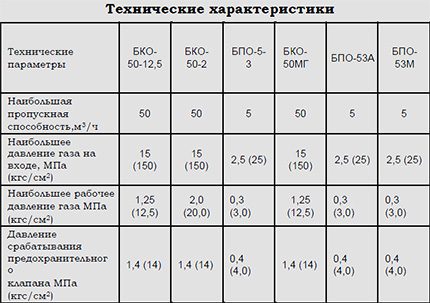
The indicators can be correlated using data on the density of the main bottled gases (kg / m3) at a temperature of 190C and standard atmospheric pressure:
- nitrogen: 1.17;
- argon: 1.67;
- acetylene: 1.10;
- butane: 2.41;
- hydrogen: 0.08;
- helium: 0.17;
- oxygen: 1.34;
- propane: 1.88;
- carbon dioxide: 1.85.
When recalculating indicators for household stoves, a problem may arise related to the proportion of propane and butane in gas cylinders. Their percentage ratio for various climatic regions is regulated by GOST 20448-90.
The density of the gas mixture depends on its percentage composition. For example, with the stated ratio of 60% propane and 40% butane, the gas density can be calculated as follows:
q = 1.88 * 0.6 + 2.41 * 0.4 = 2.09 kg / m3.
So, if the maximum gas flow rate of a four burner stove is 0.84 m3/ hour, then the gearbox should provide the same volume pass. In terms of kilograms, this value will be 2.09 * 0.84 = 1.76 kg / hour.
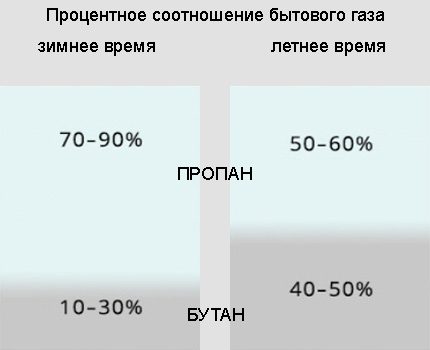
25% should be added to the calculated value of the maximum transmission capacity of the gearbox.
This is due to the following reasons:
- gas mixture parameters may vary depending on the region, season and supplier;
- the gas density, which is taken in the calculations, depends on its temperature;
- possible loss of spring elasticity, which regulates the volume of the low-pressure chamber in the gearbox, resulting in a decrease in its maximum throughput.
Sometimes complete with modern equipment they offer a pressure-tested reducer with pressure regulator in case of using a gas cylinder with propane. This option is optimal from the point of view of fire safety and system operability.
Design Features and Maintenance
Hassle-free operation of the system is impossible without regular maintenance and elimination of minor malfunctions of the gearbox. To do this, you need to know the design of the device and the signs of typical problems.
Scheme of direct and reverse devices
According to the type of design, gearboxes are divided into devices of direct and reverse action. In the first case, the overpressure of the incoming gas is directed to open the valve, in the second, the lack of pressure in the working chamber of the device.
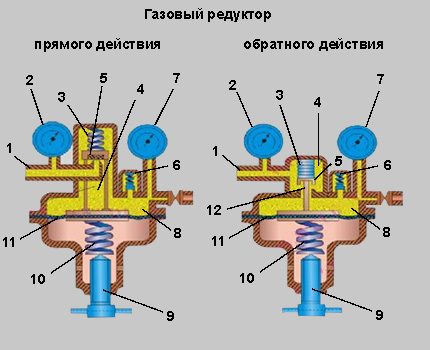
The main elements of both types of gearbox designs are the same:
- fitting through which gas is supplied;
- high pressure gauge showing the pressure value of the gas supplied to the device;
- return spring working to close the valve;
- high pressure chamber;
- a valve, the position of which regulates the volume of gas flow;
- a safety valve that operates when an unacceptable pressure is reached in the working chamber;
- low pressure gauge that determines the value of the working gas pressure;
- working chamber (low pressure);
- adjusting screw that determines the position of the membrane;
- main spring;
- the membrane of the working chamber;
- pin between main spring and check valve.
Reverse gear reducers are more common, as they are more reliable.
There are models equipped with a pneumatic pressure sensor, where instead of the main spring, gas acts on the membrane, ensuring the balance of the system.
As a rule, the adjusting screw has a tight stroke. This is due to the prevention of spontaneous changes in position under the action of forces directed to the membrane. When it is rotated clockwise, the volume of the working chamber decreases and the pressure of the outgoing gas increases.
In ordinary gearboxes, the unevenness of the outlet pressure depends on the inlet value and, as a rule, reaches 15-20%. Two-stage (or two-chamber) models are used if it is necessary to maintain the exact pressure of the exhaust gases.
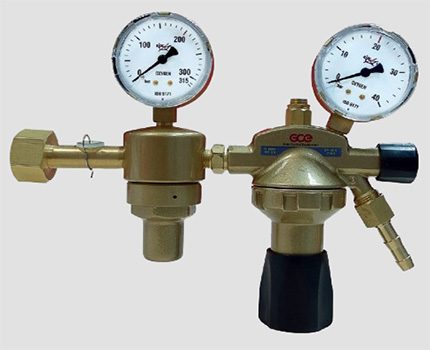
Such gearboxes have a more complex device and slightly larger dimensions. They cost more than their single-stage counterparts. Therefore, in the absence of need, their use is impractical.
Periodic inspection and maintenance work
For the long and correct operation of the gearbox, it is necessary to periodically carry out simple procedures with it. Once a week you need to record the pressure gauge. With a decrease in spring elasticity, a slow but constant decrease or increase in pressure is possible.
Once a quarter, you must perform the following actions:
- Check gaskets for leaks, safety valve and manometers with the device case.This procedure can be performed by applying a soap solution to the places of a possible gas leak.
- Purge the safety valvebut to prevent sticking. To do this, it is necessary to connect the gearbox to a source of compressed air and, with the outlet closed, increase the pressure until the protective mechanism operates.
It is impossible to carry out repair and maintenance work related to the physical impact on the device body (including the tightening of threaded connections) when the gearbox is under pressure.
It is dangerous to release and ignite combustible gases. In addition, a sharp depressurization of the device may occur with possible physical damage to people in the room.
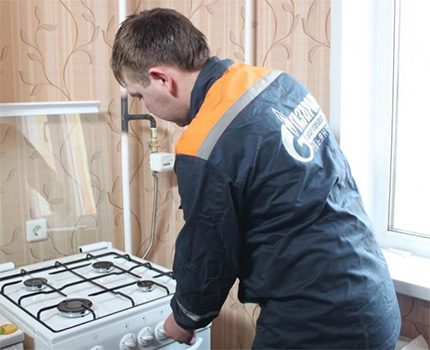
Typical faults and their repair
Gas leakage and pressure deviation outside the normative range can be eliminated independently. The first problem may be caused by the following reasons:
- depressurization of the housing;
- membrane damage.
The gas passage through the loose connection of the housing elements can be eliminated by replacing the liner or by applying silicone sealant. A damaged membrane must be replaced with a similar element from the repair kit.
The reasons for the deviation of the pressure value can be:
- The problem is with the spring. It is necessary to disassemble the gearbox and determine the cause of the failure. In case of spring displacement, it is necessary to correct it; in case of breakage, replace it. If there is a loss of elasticity, then it is enough to put a solid gasket under it.
- Leakage of compressed gas in devices with the pneumatic principle of pressure on the membrane. It is very difficult to fix the problem yourself. Gearbox replacement required.
- The problem with the membrane. If a break occurs, it is necessary to replace the device assembly, and in case of loss of tightness at the joints with washers, eliminate this malfunction by pulling the edges.
- Bypass valve problem. If there is wear on the rubber gasket, it must be replaced. In case of violation of the movement of the rocker arm, the joints must be replaced.
Given the low cost of gearboxes, it is advisable to repair it only if it is not possible to quickly replace it. If, as a result of actions with the device, it was disassembled, then for safety reasons it is necessary to check its tightness at the first start.
Conclusions and useful video on the topic
Video # 1. Simple reducer design for five liter bottles:
Video # 2. An example of repair of common gearboxes of the BKO series:
The choice of a gearbox for a system based on liquefied gas must be made taking into account the required pressure and flow volume. Simple maintenance and timely elimination of minor malfunctions will allow the device to perform its functions for a long time and with high quality.
Please write comments in the block below. Tell us about the choice of the gearbox that you put on the gas bottle, write about the rules of operation of the device. Ask questions, share opinions and photos on the topic of the article.

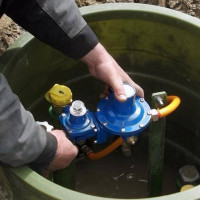 Pressure reducer for gas tank: operating principle, design features and replacement instruction
Pressure reducer for gas tank: operating principle, design features and replacement instruction 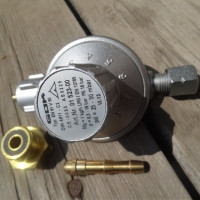 Why the gas cylinder gearbox buzzes: what to do if the gas pressure regulator is noisy
Why the gas cylinder gearbox buzzes: what to do if the gas pressure regulator is noisy 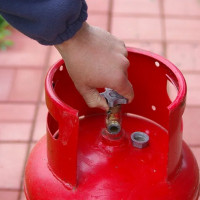 How to drain condensate from a household gas cylinder: the nuances of condensation formation + instructions for draining
How to drain condensate from a household gas cylinder: the nuances of condensation formation + instructions for draining 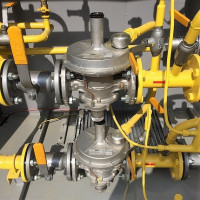 Gas pressure relief valve: types of devices + selection guidelines
Gas pressure relief valve: types of devices + selection guidelines  Characteristics of typical 50 liter gas cylinders: design, dimensions and weight of the cylinder
Characteristics of typical 50 liter gas cylinders: design, dimensions and weight of the cylinder 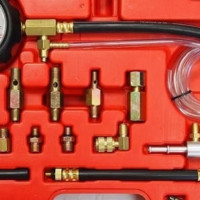 Pressure gauges for measuring gas pressure: types, design features and operation of meters
Pressure gauges for measuring gas pressure: types, design features and operation of meters  How much does it cost to connect gas to a private house: the price of organizing gas supply
How much does it cost to connect gas to a private house: the price of organizing gas supply  The best washing machines with dryer: model rating and customer tips
The best washing machines with dryer: model rating and customer tips  What is the color temperature of light and the nuances of choosing the temperature of the lamps to suit your needs
What is the color temperature of light and the nuances of choosing the temperature of the lamps to suit your needs  Replacement of a geyser in an apartment: replacement paperwork + basic norms and requirements
Replacement of a geyser in an apartment: replacement paperwork + basic norms and requirements
In the village we have gas not supplied to all houses, at first we tried with small gas cylinders for cooking during a power outage, this was especially true in the summer. Then we stopped bringing and exchanging small gas cylinders (empty ones were taken and given out full for a small cost) and we bought a large cylinder. We needed a gas reducer, but on our own we were forbidden to install it and gas workers went home. Is it true that the acquisition and installation can be independent ?!
I’m hearing from you for the first time that there are any legislative obstacles for the self-installation of the gearbox on a gas cylinder. If they took money from you for the installation, then I think the only thing is that. Invented to earn.
Hello. The rules for using domestic gas are the same for everyone: “The population is prohibited: 3.1. To carry out independent gasification of the house (apartment, garden house), rearrangement, replacement and repair of gas appliances, cylinders and valves.“